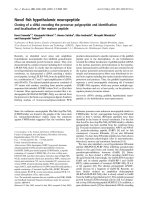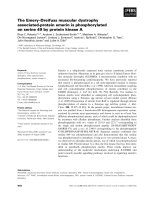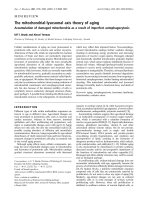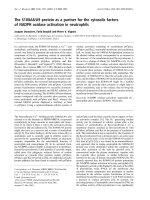Báo cáo y học: "The Colombian conflict: a description of a mental health program in the Department of Tolima" pdf
Bạn đang xem bản rút gọn của tài liệu. Xem và tải ngay bản đầy đủ của tài liệu tại đây (166.96 KB, 6 trang )
BioMed Central
Page 1 of 6
(page number not for citation purposes)
Conflict and Health
Open Access
Short report
The Colombian conflict: a description of a mental health program
in the Department of Tolima
Elisabeth Sanchez-Padilla
1
, German Casas*
2
, Rebecca F Grais
1,3
,
Sarah Hustache
1
and Marie-Rose Moro
2,4,5
Address:
1
Epicentre, 8 rue Saint Sabin, 75011, Paris, France,
2
Médecins Sans Frontières France, 8 rue Saint Sabin, Paris, France,
3
Harvard
Humanitarian Initiative, Harvard University Cambridge, 14 Story Street, Cambridge, MA 02138, USA,
4
Hôpital Avicenne, Assistance Publique
Hôpitaux de Paris, Université de Paris 13, 125 rue de Stalingrad, 93009 Bobigny, France and
5
Hôpital Cochin, Maison des adolescents, Université
de Paris 5, 97 Bd de Port Royal, 75679, Paris cedex 14, France
Email: Elisabeth Sanchez-Padilla - ; German Casas* - ;
Rebecca F Grais - ; Sarah Hustache - ; Marie-Rose Moro - marie-
* Corresponding author
Abstract
Colombia has been seriously affected by an internal armed conflict for more than 40 years affecting
mainly the civilian population, who is forced to displace, suffers kidnapping, extortion, threats and
assassinations. Between 2005 and 2008, Médecins Sans Frontières-France provided psychological
care and treatment in the region of Tolima, a strategic place in the armed conflict. The mental
health program was based on a short-term multi-faceted treatment developed according to the
psychological and psychosomatic needs of the population. Here we describe the population
attending during 2005-2008, in both urban and rural settings, as well as the psychological treatment
provided during this period and its outcomes.
We observed differences between the urban and rural settings in the traumatic events reported,
the clinical expression of the disorders, the disorders diagnosed, and their severity. Although the
duration of the treatment was limited due to security reasons and access difficulties, patient
condition at last visit improved in most of the patients. These descriptive results suggest that
further studies should be conducted to examine the role of short-term psychotherapy, adapted
specifically to the context, can be a useful tool to provide psychological care to population affected
by an armed conflict.
Findings
Colombia has been seriously affected by an internal
armed conflict for more than 40 years. The "guerrillas,"
the Revolutionary Armed Forces of Colombia (FARC) and
the National Liberation Army (ELN), paramilitary groups
and the governmental military, control different aspects
of the social and political landscape. Civilian populations
are the main victims of this conflict, forced to displace,
suffering kidnapping, extortion, threats or assassinations.
Due to the security problems, very few medical actors are
present and even less mental health professionals are able
to work in the region. Médecins Sans Frontières-France
(MSFF) has been working in mental health support pro-
Published: 23 December 2009
Conflict and Health 2009, 3:13 doi:10.1186/1752-1505-3-13
Received: 22 July 2009
Accepted: 23 December 2009
This article is available from: />© 2009 Sanchez-Padilla et al; licensee BioMed Central Ltd.
This is an Open Access article distributed under the terms of the Creative Commons Attribution License ( />),
which permits unrestricted use, distribution, and reproduction in any medium, provided the original work is properly cited.
Conflict and Health 2009, 3:13 />Page 2 of 6
(page number not for citation purposes)
grams in the department of Tolima, Colombia, since
2002. Tolima, which groups 47 municipalities, is consid-
ered a strategic corridor in the armed conflict in Colom-
bia, and has been occupied for more than 30 years.
The MSFF mental health program in Tolima was based on
a short-term multi-faceted treatment developed according
to the psychological and psychosomatic needs of the pop-
ulation. Here, we describe the population attending dur-
ing 2005-2008, as well as the psychological treatment
provided during this period and its outcomes.
Between 2005 and 2008, MSFF provided psychological
care and treatment in Ibague, the capital of the depart-
ment of Tolima, and in various rural villages. Three men-
tal health teams provided services: two were mobile
within the rural areas and one was based in Ibague. They
were comprised of expatriate and local psychologists or
psychiatrists working jointly with the medical officers.
The population attended differed in these two settings. In
Ibague, everyone considered internally displaced by the
Secretaria Departamental de Salud (regional health author-
ity), was refereed to the MSFF clinic in order to asses their
health and psychological condition. Rural villages were
included in the program if the civilian population suf-
fered recent or long-term violent events, threats of violent
events or if a large number of displaced persons settled
there. In Ibague, middle-term psychological treatment
with an open schedule of sessions was offered through the
mental health ambulatory center. In the rural areas, short-
term treatment with a fixed schedule of session (five) was
offered through the use of mobile clinics; the first session
occurred ideally, less than one month after a violent event.
At the last visit, the condition of the patient was assessed
and, if considered necessary, they were referred to a gov-
ernmental institution to continue treatment.
Mental health activities consisted of psycho-informative
activities and psychological treatment. The psycho-
informative sessions were collective meetings, conducted
by a psychologist, where the entire population was invited
to attend. These sessions were designed to inform the
rural population about the symptoms and consequences
of traumatic events, to offer tips and advice on coping
mechanisms, and an explanation of the mechanisms of
psychotherapy. At the end of the session, the psychologist
offered the possibility of an individual consultation. In
Ibague, the physician directly referred patients to the psy-
chologist whom they considered candidates for a psycho-
logical assessment.
In the individual consultations, patients were asked to
complete a practical checklist of symptoms, signs, feel-
ings, as well as to rethink the traumatic events. Patients
screening positive for PTSD, anxiety disorders and/or
depression, based on criteria from the DSM IV adapted to
the Colombian context, were offered individual psycho-
logical treatment, and then referred for a more complete
psychological assessment. Patients were not included in
the psychological program if they presented: chronic psy-
chotic disorders, mental retardation or other mental
health conditions not in relationship with the internal
armed conflict. In case of exclusion, the patient was
referred to the local health system. For those patients
admitted, severity of the condition was assessed consider-
ing the number and intensity of the signs and symptoms
of the disorder, and any resulting impairment in occupa-
tional or social functioning. Two types of psychological
treatment were offered: individual psychotherapy and
therapeutic groups. Individual psychotherapies were
based on a short-term psychotherapy model. A rigorous
treatment schedule was used in order to assure adherence
to the treatment and the fulfillment of the objectives. Dur-
ing each 45-minute session, the psychologist performed
therapeutic interventions in order to help the patient
understand the relationship between the traumatic events
and the current symptoms. Patients were invited to
describe their personal history and visual or hearing mem-
ories. Group sessions were developed based on a psycho-
therapy group model. During the first session, patients
were informed about the rules of the group therapies, the
schedule, the need for confidentiality and the objectives
of the treatment. For children, D.W. Winnicott techniques
[1,2] were adapted and used; for infants and young chil-
dren under three, we employed mother-baby dyads. In
order to assess difficulties and the functioning of the
mother-child interaction [3], we used Lebovici technique
based on a psychodynamic brief psychotherapy model
[4,5]. In addition to psychotherapy, patients with depres-
sion or anxiety that met the following criteria received
psychotropic medication: disorders that did not allow the
patient to carry out basic daily activities, experience of sui-
cidal ideas, significant disturbances of consciousness, no
response or aggravated clinical criteria after psychological
treatment. Psychotropic medication was either fluoxetine
and/or amytryptiline.
The patient's condition at last visit was classified as aggra-
vated, unchanged, or improved based on the number of
DSM IV criteria met and the overall condition reported by
the patient and the psychologist. The outcome was
defined as improved if a decrease of at least 80% in the
total number of DSM IV criteria met initially was
observed, or if an improvement regarding daily activities,
personal abilities, or capacity for problem-solving com-
pared with the initial evaluation was seen. It was defined
as unchanged if the patient did not show changes in the
number of DSM IV criteria met or improvement in daily
activities, personal abilities, problem solving or coping
Conflict and Health 2009, 3:13 />Page 3 of 6
(page number not for citation purposes)
mechanisms. The clinical outcome was defined as aggra-
vated if there was an increase in the number of criteria
met, or there was a new DSM IV diagnoses or if the
patients themselves reported aggravated symptoms.
All data were entered into EpiData version 2.0 (EpiData
Association, Odense, Denmark). Analysis was conducted
using Stata 9.2 (Stata Corporation, College Station,
Texas). Medians are given with inter-quartiles range (IQR)
[25%-75%] and were compared using the Kruskal-Wallis
test. Percentages were compared using the Fisher exact
test. Results are presented separately for patients treated in
Ibague and in the rural villages.
Between February 2005 and February 2008, the program
treated 2,411 people: 855 (35.5%) in Ibague and 1,556
(64.5%) in the villages. The majority of patients were
adults (older than 14 years) (75.1%; 1,811/2,411), and
women (67.6%; 1,624/2,404). The median (IQR) age for
children under 15 was 10 years (8-12), both in Ibague and
in the villages. For adults, the median (IQR) age in Ibague
and in the rural area was 39 years (28-48) and 40 year (28-
52), respectively (Table 1).
Among the different traumatic events reported, the most
frequent in children in Ibague was being forced to flee,
followed by the presence of family violence. In the vil-
lages, the most frequent traumatic events reported among
children were witnessing murders or physical abuse, hav-
ing suffered the break up of the nuclear family and suffer-
ing family violence. For adults treated in Ibague, having
been forced to flee was the main traumatic event reported,
followed by having received threats and having lost or
destroyed property. In the rural areas, among adults, the
most frequent traumatic events were having witnessed
murder or physical abuse and having a close family mem-
ber killed (Table 2).
Table 1: Socio-demographic characteristics of the population
treated.
Ibague
(n = 855)
Rural area
(n = 1,556)
n% n %
Sex
Male 293 34.4 487 31.4
Female 559 65.6 1,065 68.6
Age group
Under 15 143 16.7 454 29.2
15 or more 713 83.3 1,101 70.8
Place of residence
Ibague 841 98.4 7 0.5
Rural village 14 1.6 1,544 99.5
Department of Tolima, Colombia, 2005-2008.
Table 2: Traumatic events reported by the patients.
Ibague Rural Areas p-value
nN % nN %
Children*
Sexual violence 11 / 113 9.7 21 / 454 4.6 0.042
Physical injury 4 / 110 3.6 4 / 453 0.9 0.051
Close family member killed 30 / 115 26.1 56 / 454 12.3 0.001
Close family member died from illness 7 / 112 6.3 25 / 454 5.5 0.819
Witness of murder or physical abuse 19 / 123 15.4 85 / 454 18.7 0.431
Received threats 47 / 119 39.5 17 / 454 3.7 <0.001
Incarceration 1 / 111 0.9 8 / 453 1.8 1.000
Property lost or destroyed 45 / 121 37.2 4 / 453 0.9 <0.001
Being forced to flee 137 / 142 96.5 22 / 453 4.9 <0.001
Break-up of nuclear family 51 / 121 42.1 80 / 452 17.7 <0.001
Family violence 110 / 143 76.9 78 / 454 17.2 <0.001
Adults
Sexual violence 47 / 379 12.4 44 / 1,101 4.0 <0.001
Physical injury 32 / 362 8.8 22 / 1,101 2.0 <0.001
Close family member killed 141 / 433 32.6 166 / 1,100 15.1 <0.001
Close family member died from illness 27 / 367 7.4 108 / 1,101 9.8 0.176
Witness of murder or physical abuse 135 / 466 29.0 170 / 1,101 15.4 <0.001
Received threats 590 / 698 84.5 137 / 1,101 12.4 <0.001
Incarceration 4 / 347 1.2 22 / 1,101 2.0 0.362
Property lost or destroyed 432 / 692 62.4 38 / 1,101 3.5 <0.001
Being forced to flee 702 / 710 98.9 80 / 1,101 7.3 <0.001
Break-up of nuclear family 212 / 459 46.2 151 / 1,100 13.7 <0.001
Family violence 135 / 712 19.0 133 / 1,099 12.1 <0.001
Department of Tolima, Colombia, 2005-2008.
* Younger than 15 years old.
Conflict and Health 2009, 3:13 />Page 4 of 6
(page number not for citation purposes)
The main clinical expression presented was distress or
anxiety (39.9%; 943/2,366) and sadness or crying
(39.3%; 930/2,366). The most frequent diagnosis was
"other anxiety disorder" (32.3%; 750/2,323), which
included all anxiety disorders not classified as PTSD or
acute stress disorder, followed by depression (18.2%;
423/2,323), acute stress disorder (9.9%; 230/2,323) and
PTSD (8.4%; 196/2,323) (Table 3). Most disorders were
classified as "moderate", both in children (64.0%; 375/
586) and adults (64.3%; 1,144/1,779). The percentage of
psychopathologies classified as severe was higher in the
villages (14.6%; 220/1,509) than in the city (6.4%; 55/
856) (p < 0.001), and in adults (13.0%; 232/1,779) than
in children (7.3%; 43/586) (p < 0.001).
Regarding treatment, both children and adults more fre-
quently received individual psychotherapy (table 4). The
median (IQR) number of psychotherapy sessions for chil-
dren in Ibague was 3 (2-4) and in the villages 2 (1-3). In
adults, the median (IQR) number of sessions was 2 (2-4)
in Ibague and 2 (1-3) in the villages. In addition to the
psychotherapy, 37.0% (407/1,100) and 27.9% (198/711)
of adult patients from Ibague and rural areas, respectively,
were prescribed psychotropic drugs. This proportion was
Table 3: Main clinical expression and diagnosis.
Main clinical expression Ibague Rural area p-value
n% N %
Children* (n = 143) (n = 442)
Sadness, crying 33 23.1 90 20.4 0.481
Distress, anxiety 61 42.7 137 31.0 0.011
Inhibition, withdrawal 23 16.1 77 17.4 0.799
Unspecific 22 15.4 127 28.7 0.001
Other 4 2.8 11 2.5 0.768
Adults (n = 712) (n = 1,069)
Sadness, crying 373 52.4 434 40.6 <0.001
Distress, anxiety 247 34.7 498 46.6 <0.001
Inhibition, withdrawal 36 5.1 18 1.7 <0.001
Unspecific 39 5.5 104 9.7 0.001
Other 17 2.4 15 1.4 0.146
Main diagnosis
Children* (n = 141) (n = 437)
Acute stress disorder 24 17.0 6 1.4 <0.001
PTSD 7 5.0 59 13.5 0.006
Other anxiety disorder 16 11.4 159 36.4 <0.001
Depression 20 14.2 21 4.8 0.001
Adjustment disorder 26 18.4 10 2.3 <0.001
Parent-child relational problems 7 5.0 53 12.1 0.016
Other 41 29.1 129 29.5 1.000
Adults (n = 683) (n = 1,062)
Acute stress disorder 173 25.3 27 2.5 <0.001
PTSD 33 4.8 97 9.1 0.001
Other anxiety disorder 94 13.8 481 45.3 <0.001
Depression 139 20.4 243 22.9 0.236
Adjustment disorder 153 22.4 8 0.8 <0.001
Parent-child relational problems 0 0.0 39 3.7 <0.001
Other 91 13.3 167 15.7 0.189
Department of Tolima, Colombia, 2005-2008.
* Younger than 15 years old.
Table 4: Type of psychotherapy received.
Ibague Rural area
Type of therapy n % n %
Children* (n = 131) (n = 432)
Individual 112 85.5 275 63.7
Grouped 7 5.3 111 25.7
Dyad 12 9.2 46 10.7
Adults (n = 708) (n = 1,099)
Individual 691 97.6 976 88.8
Grouped 10 1.4 85 7.7
Dyad 7 1.0 38 3.5
Department of Tolima, Colombia, 2005-2008.
* Younger than 15 years old.
Conflict and Health 2009, 3:13 />Page 5 of 6
(page number not for citation purposes)
11.2% (16/143) and 30.0% (136/454) for children,
respectively. Regarding treatment outcome, the most fre-
quent clinical condition in the last consultation was
"improved" (table 5).
There are few studies of mental health in the violent
Colombian context [6-8]. Although patients treated in
both settings were affected by the same conflict, we
observed differences between the urban and rural setting
in the traumatic events reported, the clinical expression of
the disorders, the most frequent disorders diagnosed, and
their severity. These differences may be explained by the
displacement itself. Among the displaced living in Ibague,
exposure to violent traumatic events was not recent. The
urban population faced other challenges related with re-
location and urban adaptation. These aspects could
explain the higher number of adjustment disorders and
acute stress disorders found in the urban area. Similarly,
as the conflict was active in the rural area, this may also
help explain the higher proportion of severe cases in the
rural setting. Examining the correlation between the dif-
ferences in the experience of traumatic events, symptom
severity and diagnoses, although important, is beyond the
scope of this study. Our objective was to provide a first
descriptive analysis that could provide the basis for future
studies.
Although the duration of the treatment was limited due to
security reasons and access difficulties, the patient's condi-
tion at last visit had improved in most of the patients: over
90% of our patients saw their clinical status improved on
their last visit. The absence of a control group did not
allow us to develop comparative analysis and therefore we
cannot state that this improvement is due solely to the
type of psychotherapy received. It would be interesting to
look at the role of other factors, such as severity, medica-
tion, main diagnosis, although it is beyond the objective
of this manuscript to identify predictors of clinical out-
come, which might be an interesting second step in the
future. A specific data collection and analysis plan would
need to be put in place to address these questions.
These descriptive results suggest that further studies
should be conducted to examine the role of short-term
psychotherapy, adapted specifically to the context, can be
a useful tool to provide psychological care to population
affected by an armed conflict. Short-term psychotherapy,
adapted specifically to the context, through the integra-
tion of the culturally variable representations of illness,
suffering and treatment [9,10], may be the only viable
possibility to offer mental health care in conflict. Other
studies should be conducted to elucidate the benefits and
constraints of short-term psychotherapy in conflict.
Ethical considerations
This manuscript is based on routinely-collected data from
the MSFF program in Colombia. Authorization for analyz-
ing and publishing the data was sought from the Secretaría
de Salud Departamental de Tolima.
Competing interests
The authors declare that they have no competing interests.
Authors' contributions
ESP had full access to all of the data in the study and takes
responsibility for the accuracy of the data analysis. GC and
MRM participated in the interpretation of the results. GC,
SH, RFG and MRM participated in the critical revision of
the manuscript. All authors read and approved the final
manuscript.
Acknowledgements
We authors would like to thank the dedicated field teams of Médecins Sans
Frontières-France who contributed with their effort to this article, and the
Secretaria Departamental de Salud of Tolima for the support provided to the
project.
References
1. Winnicott DW: The child, the family, and the outside world London: Pen-
guin; 1964.
2. Winnicott DW: Playing and Reality London: Tavistock; 1971.
3. Rezzoug D, Baubet T, Broder G, Taieb O, Moro MR: Addressing
the mother infant relationship in displaced communities.
Child Adolesc Psychiatr Clin N Am 2008, 17:551-68.
4. Lebovici S, Diatkine R, Soule M: Nouveau traité de psychiatrie de l'enfant
et de l'adolescent Paris: PUF; 2004.
Table 5: Clinical condition in the last visit. Department of Tolima, Colombia, 2005-2008
Ibague Rural area p-value
Condition in last consultation n % n %
Children* (n = 117) (n = 324)
Aggravated or Unchanged 13 11.11 33 10.19 0.860
Improved 104 88.89 291 89.81
Adults (n = 500) (n = 744)
Aggravated or Unchanged 47 9.4 61 8.2 0.473
Improved 453 90.6 683 91.8
* Younger than 15 years old.
Publish with Bio Med Central and every
scientist can read your work free of charge
"BioMed Central will be the most significant development for
disseminating the results of biomedical researc h in our lifetime."
Sir Paul Nurse, Cancer Research UK
Your research papers will be:
available free of charge to the entire biomedical community
peer reviewed and published immediately upon acceptance
cited in PubMed and archived on PubMed Central
yours — you keep the copyright
Submit your manuscript here:
/>BioMedcentral
Conflict and Health 2009, 3:13 />Page 6 of 6
(page number not for citation purposes)
5. Lebovici S: Technical Remarks on the Supervision of Psycho-
analytic Treatment. Int J Psychoanal 1970, 51:382-392.
6. Harpham T, Snoxell S, Grant E, Rodriguez C: Common mental dis-
orders in a young urban population in Colombia. Br J Psychiatry
2005, 187:161-167.
7. Puertas G, Rios C, del Valle H: The prevalence of common men-
tal disorders in urban slums with displaced persons in
Colombia. Rev Panam Salud Publica 2006, 20:324-330.
8. Perez-Olmos I, Fernandez-Pineres PE, Rodado-Fuentes S: The prev-
alence of war-related post-traumatic stress disorder in chil-
dren from Cundinamarca, Colombia. Rev Salud Publica (Bogota)
2005, 7:268-280.
9. Sturm G, Moro MR: Mobilizing Social and Symbolic Resources
in Transcultural Therapies with Refugees and Asylum Seek-
ers. In Voices of Trauma. Treating Survivors across Cultures Edited by:
Drozdek B, Wilson JP. New York: Springer; 2009:211-213.
10. Moro MR, Lebovici S: Psychiatrie humanitaire en ex-Yougosla-
vie et en Arménie, . Face au traumatisme 2005.









